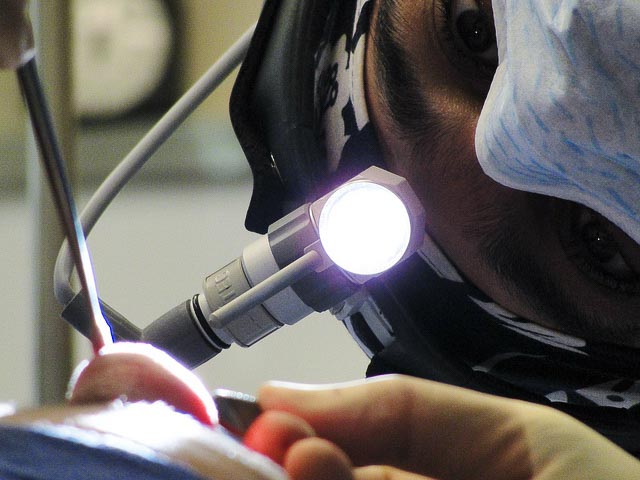Research Over Coffee is a new series in which we unearth the work of area researchers and explain it succinctly in everyday terms. It’s world-class research that you’ll enjoy reading over a cup of coffee.
In 2009, President Obama sought to build support for workforce training efforts while the country was battling the lows of the recession.
“The notion that we would have to import nurses makes absolutely no sense…” he said.
That statement didn’t go over well in some circles. Some foreign-born healthcare workers took it as an indication that they were unappreciated, or worse, that a wide-open door of opportunity could be closing.
Regardless of how it was interpreted, however, one thing’s clear: the American healthcare industry depends heavily on foreign-born workers. In 2010, 16 percent of all U.S. healthcare workers (1.8 million people) were foreign born. Among physicians and surgeons, 27 percent are foreign born, and 22 percent of nurses, psychiatrists and home health aides are as well.
At the same time, the Texas Medical Center is the largest medical complex in the world. It’s located in Houston, the most racially and ethnically diverse metropolitan city in the country.
Put it all together, and what does it mean? Immigrant health workers play a critical role in the fabric of Houston. Researchers from University of Houston – Clear Lake wanted to take a closer look at that relationship between foreign health workers and the city.
The Question
How are foreign-born healthcare workers in Houston assimilating to American culture and changing Houston in the process?
What Previous Research Had Shown
Noted sociologist Milton Gordon studied how turn-of-the-19th-century immigrant populations were assimilating into American cities. He outlined a seven-stage process by which those immigrants would become indistinguishable from native-born residents.
Crucial to that process is joining clubs and institutions that are part of the broader civic structure. Eventually, he thought, immigrants reach a point where they’re more concerned with the common good than asserting their own non-American values.
Interestingly, more recent researcher points to a different trend. American culture tends to absorb cultural elements of specific immigrant groups, rather than those immigrant groups slowly abandoning them.
Critics of the country’s immigration policy focus on the perceived negative effects of low-skill immigrants. But in reality, at least 25 percent of today’s immigrants are highly skilled – including those who increasingly make up the American healthcare workforce.
The Study and Findings
The researchers used Census data and interviews with members of nurse associations for Filipino, Indian, Nigerian and Vietnamese immigrants working in Houston-area hospitals.
They wanted to determine whether those workers were joining large civic organizations and engaging with Houston’s broader civic conversations.
They found that Fort Bend County – now the most racially and ethnically diverse in the Houston area –attracts immigrant groups not just because of its proximity to the Texas Medical Center, but specifically because it is so diverse.
“It’s just such a joy to live where people understand you, where you can find places to eat and shop,” said one Indian-American nurse who lives in Sugar Land, in a typical response. “We are not the foreigners; everyone is a foreigner or looks like they could be, if you know what I mean.”
Medical professionals are able to buy homes in Fort Bend County immediately, due to their relatively high salaries, rather than experiencing gradual upward mobility that had been found from previous research.
The researchers also found that foreign-born healthcare workers were transforming Houston’s healthcare industry by improving its ability to effectively treat racially and ethnically diverse populations. That’s because foreign doctors and nurses speak patients’ native languages and are aware of specific cultural sensitivities. They can also raise awareness of health risks within specific ethnic communities.
The Filipina community, for example, needs more attention for high blood pressure, nurses said. And Helicobacter pylori infections disproportionately affect the Vietnamese community.
Foreign-born workers aren’t just filling a labor need, the researchers concluded. “They are also transforming healthcare by drawing attention and education to specific needs and trends within their own ethnic communities,” the study reads.
The Implications
The study offers three strong conclusions.
- Growing diversity in places like Fort Bend County is significantly influenced by foreign-born workers. Because they have relatively high salaries, that diverse influx of residents is also raising median incomes in the area, increasing property values, and ultimately raising the level of school funding and quality of education for the area.
- Foreign-born workers are filling the healthcare industry’s need for high-skilled workers, and based on their backgrounds, making Houston’s healthcare system more effective.
- Rather than becoming “more American” over time, as previous researchers have theorized, these healthcare workers are making an immediate impact on their communities and the fields in which they work. That dynamic challenges previous assumptions about how immigrants assimilate to their new homes as well as how they participate in civic life upon arrival.
This study is part of the Metropolises’ Responses to Migration and Urban Growth (MR. MUG) project and was commissioned by the Kinder Institute for Urban Research.
Assimilation and Transformation through Healthcare: Case of Houston Foreign-born Healthcare Workers and their Community Engagement | Stephen M. Cherry, University of Houston – Clear Lake; Amy E. Lucas, University of Houston – Clear Lake.

